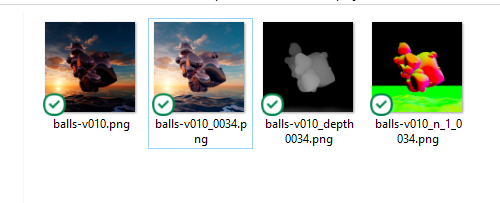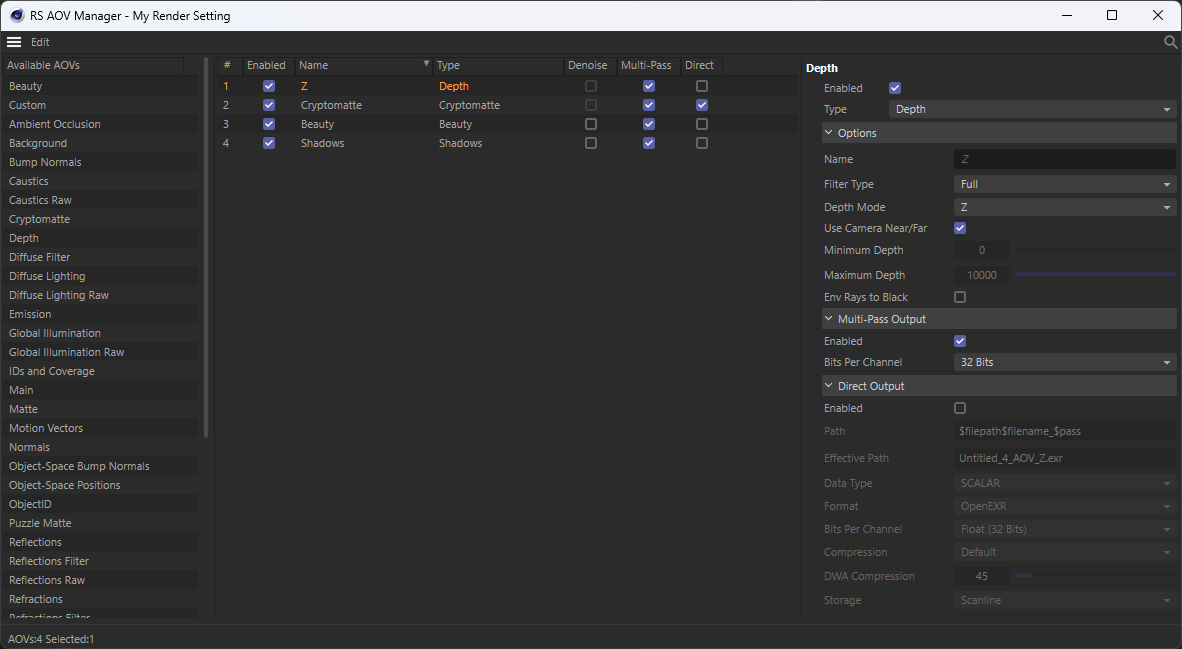get the names of redshift multi passes AOV names from the render settings
-
I am looking for a way to read out the multipass names of my redshift rendersettings, such as 'Z' or 'depth'
in the code below the script successfully gives me the path at the very last print statement. I am looking for the other MP filenames
filepath 2: C:\Users\thoma\Dropbox\trauminc\projects\832-control_net\work\CG\c4d\balls\render\balls-v010\balls-v010.png, 1023671defined in the render settings. such asballs-v010_depth0034def render(self, url): print(f"are we rendering? {self.rendering}") if self.rendering: return self.rendering = True doc = c4d.documents.GetActiveDocument() docClone = doc.GetClone() rd = doc.GetActiveRenderData() print(f"render data: {rd}") print(f"multipass {rd.GetFirstMultipass()}") bmPreview = c4d.bitmaps.BaseBitmap() bmPreview.Init(int(rd[c4d.RDATA_XRES]), int(rd[c4d.RDATA_YRES])) print("starting to render") result = c4d.documents.RenderDocument( docClone, rd.GetData(), bmPreview, c4d.RENDERFLAGS_EXTERNAL, th=None ) if result == c4d.RENDERRESULT_OK: filepath = rd[c4d.RDATA_PATH] print(f"filepath: {filepath}") if "$" in filepath: filepath = self.resolve_and_normalize_path(filepath, doc, rd) file_format = rd[c4d.RDATA_FORMAT] print(f"file_format: {file_format}") filepath += self.get_extension_for_format(file_format) print(f"filepath 2: {filepath}, {file_format}") bmPreview.Save(filepath, file_format) self.send_image_to_server(filepath, URL) self.rendering = False def resolve_and_normalize_path( self, tokenized_path, doc, rd): # Define the rpData dictionary to resolve tokens rpData = { "_doc": doc, "_rData": rd, "_rBc": rd.GetData(), # "_frame": 2, # Replace this with the actual frame number if available # Add any other needed data here } # Convert the tokens to their actual values filepath = c4d.modules.tokensystem.StringConvertTokens(tokenized_path, rpData) # Check if the filepath is absolute if not os.path.isabs(filepath): # If not, make it absolute base_path = doc.GetDocumentPath() filepath = os.path.join(base_path, filepath) # Normalize the file path to use the standard slashes for your OS filepath = os.path.normpath(filepath) return filepathWhen I render via my plugin in RS, it renders one additional image with different colour settings. file:
balls-v010.pngin this image:
I have looked at https://github.com/PluginCafe/cinema4d_py_sdk_extended/blob/a12cca185a7a07fb20aa34520799b66007839e1e/scripts/05_modules/token_system/tokensystem_render_r17.py#L9 and its super helpful but doesn't help me with the AOVs
-
Hi @thomas ,
Here is a little function in my Renderer library, seems like what you want to do, hope it can helps

Cheers~
DunHouAOVs

Console
--- REDSHIFTRENDER --- Name: Redshift Color space: ACEScg AOV count: 4 ----------------------------------------------------------- Name :Z Type :1 Enabled :Yes Multi-Pass :Yes Direct :No Direct Path :$filepath$filename_$pass Direct Effective Path : ----------------------------------------------------------- Name :Cryptomatte Type :42 Enabled :Yes Multi-Pass :Yes Direct :Yes Direct Path :$filepath$filename_$pass Direct Effective Path :Untitled_4_AOV_Cryptomatte.exr ----------------------------------------------------------- Name :Beauty Type :41 Enabled :Yes Multi-Pass :Yes Direct :No Direct Path :$filepath$filename_$pass Direct Effective Path : ----------------------------------------------------------- Name :Shadows Type :23 Enabled :Yes Multi-Pass :Yes Direct :No Direct Path :$filepath$filename_$pass Direct Effective Path : --- REDSHIFTRENDER ---Codes
import c4d from Renderer import Redshift def main() -> None: # Get the doc host the aovs, in this case th active doc doc: c4d.documents.BaseDocument = c4d.documents.GetActiveDocument() # Set redshift AOVHelper instance aov_helper = Redshift.AOV(doc) # Print current aov info aov_helper.print_aov() if __name__ == '__main__': main() -
Hi @thomas ,
There's redshift python API that you can use for that. Please check the sample code snippet below that creates "Depth" AOV and then prints all of the existing AOVs into the console for the active document. I assume in the core @Dunhou uses this exact approach conveniently wrapped by the renderer library.
Cheers,
IliaThe sample code snippet:
import c4d import c4d.documents import redshift def CreateAOVs(vpRS): aovs = [] aov = redshift.RSAOV() aov.SetParameter(c4d.REDSHIFT_AOV_TYPE, c4d.REDSHIFT_AOV_TYPE_DEPTH) aov.SetParameter(c4d.REDSHIFT_AOV_ENABLED, True) aov.SetParameter(c4d.REDSHIFT_AOV_NAME, "My Depth") aovs.append(aov) return redshift.RendererSetAOVs(vpRS, aovs) def PrintAOVs(vpRS): aovs = redshift.RendererGetAOVs(vpRS) for aov in aovs: print("-----------------------------------------------------------") print("Name :%s" % aov.GetParameter(c4d.REDSHIFT_AOV_NAME)) # The customized name of an AOV print("Effective Name :%s" % aov.GetParameter(c4d.REDSHIFT_AOV_EFFECTIVE_NAME)) # The customized name of the AOV or a sensible default when empty # Available from 2.6.50/3.0.10 print("Type :%d" % aov.GetParameter(c4d.REDSHIFT_AOV_TYPE)) print("Enabled :%s" % ("Yes" if aov.GetParameter(c4d.REDSHIFT_AOV_ENABLED) else "No")) print("Multi-Pass :%s" % ("Yes" if aov.GetParameter(c4d.REDSHIFT_AOV_MULTIPASS_ENABLED) else "No")) print("Direct :%s" % ("Yes" if aov.GetParameter(c4d.REDSHIFT_AOV_FILE_ENABLED) else "No")) print("Direct Path :%s" % aov.GetParameter(c4d.REDSHIFT_AOV_FILE_PATH)) print("Direct Effective Path :%s" % aov.GetParameter(c4d.REDSHIFT_AOV_FILE_EFFECTIVE_PATH)) # Available from 2.6.44/3.0.05 def main(): doc = c4d.documents.GetActiveDocument() renderdata = doc.GetActiveRenderData() # Get the Redshift videoPost and render settings vprs = redshift.FindAddVideoPost(renderdata, redshift.VPrsrenderer) if vprs is None: return # Switch renderer renderdata[c4d.RDATA_RENDERENGINE] = redshift.VPrsrenderer CreateAOVs(vprs) PrintAOVs(vprs) c4d.EventAdd() if __name__=='__main__': main() -
@Dunhou @i_mazlov, thanks so much both. This really helped.
Where is the Redshift Python documentation, I tried the normal Redshift online help https://help.maxon.net/r3d/cinema/en-us/#search-python and the python plugin help.
-
Hi @thomas,
I don't think there's a single place with aggregated Redshift Python API documentation. Such things are usually discussed on redshift forums.
Cheers,
Ilia -
ok. I know not your department, but thats nuts.
Thanks!